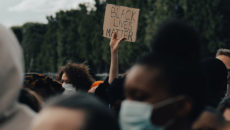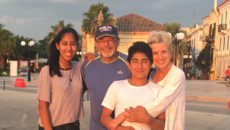Picture Books for Multiracial Families
Black is Brown is Tan, by Arnold Adoff
This delightful book was one of the first children’s books of its kind, offering readers a peek into a day in the life of a multiracial family.
Starting School, by Janet and Allan Ahlberg
One of the most exciting days in a child’s life is the first day of kindergarten. The Ahlbergs have managed to capture all of the energy and enthusiasm of this special occasion in their depiction of a multiracial kindergarten class.
Silver Shoes, by Caroline Binch
Molly is very excited about taking dance lessons, but she’s disappointed to learn that she will not be permitted to wear her grandmother’s silver dancing shoes to class. But Grandmother manages to find the perfect solution. This book features an African-American mother and a white father.
Grandfather Counts, by Andrea Cheng
Helen’s grandfather has come from China to live with her family in the United States. Helen resents the fact that she has to give up her bedroom for him, but he surprises her one day during her favorite activity, and she realizes that there is much they can learn from each other.
Black, White, Just Right!, by Marguerite Davol
Her mother is black, her father is white, but she is “just right!” A little girl tells readers all about her multiracial family.
Journey Home, by Lawrence McKay
Mai joins her mother as she takes an emotional journey to search for her birth parents in Viet Nam.
Family, by Isabell Monk
Hope’s African-American relatives are getting together for a family reunion at her great aunt’s farm. Hope brings a very…interesting dish that she explains is a family recipe from her father’s white family. Everyone is delighted by her special dessert.
Marina’s Muumuu/El Muumuu del Marina, by Evangelina Vigil-Pinon
Marina lives with her Mexican grandfather and Hawaiian grandmother. She has decided that she wants a muumuu just like the ones that she has seen in photographs of her grandmother. This story is told in both English and Spanish.
How My Parents Learned to Eat, by Ina Friedman
An American sailor meets a young Japanese woman in while stationed in Japan. Years later, their daughter explains her family’s custom of eating with forks some days and eating with chopsticks on other days.
The Way We Do It in Japan, by Geneva Cobb Iijima
Gregory’s family moves from San Francisco to Japan. He knows a little bit about “the way they do it in Japan” from his Japanese father, Hidiaki, but his mother, Jane gives him peanut butter and jelly sandwiches in a superhero lunchbox. This is not the way that they eat lunch in Japan. Gregory’s teacher finds a way to help him fit in and feel welcome during lunch.
Who Belongs Here? An American Story, by Margy Burns Knight
Nary and his grandparents immigrate to the United States as refugees from Cambodia. He’s glad to be an American citizen, and looks forward to the new life he can build, but doesn’t understand some of the hurtful comments that his classmates make to him. As Knight tells his story, she provides italicized passages that tell the broader story of immigration to this country and celebrate the resulting diversity.
Aneesa Lee and the Weaver’s Gift, by Nikki Grimes
“Aneesa, like her mother, is a weave of black, white, and Japanese.” Grimes pens a collection of poems about a multiracial girl who loves to weave.
Molly Bannaky, by Alice McGill
In this fictionalized biography, readers learn of the plight of Molly Bannaky. Falsely accused of a crime and brought to the United States as an indentured servant, Molly eventually overcomes her life circumstances. In the last pages of the book, we learn that her grandson is Benjamin Bannaker, the African American inventor and astronomer.
Bonjour Lonnie, by Faith Ringgold
In this unusual historical fantasy, Lonnie takes a trip back in time. He meets his grandparents—an African-American soldier and a French woman. His grandparents tell him all about their heroic efforts in the French Resistance, his birth parents, his multiracial heritage, and the reason Lonnie was adopted.
Novels for Multiracial Families
Ginger Brown: Too Many Houses, by Sharon Dennis Wyeth
Six-year-old Ginger Brown is biracial, and has just begun to note differences in appearance. When her parents get divorced, she spends a difficult year moving from one house to another. Fortunately, her loving extended family helps support her through feelings of anger and confusion.
Trouble at Fort La Pointe, by Kathleen Ernst
Suzette’s father is wrongly incarcerated for stealing a bale of furs from the trading post. It takes attributes of both her French and Native American heritages to find the real culprit.
The Cheetah Girls #1: Wishing on a Star, by Deborah Gregory
Five wanna-be recording stars are ready to take the world by storm! The series about these multiracial girls is up to eleven books already and shows no sign of slowing down.
Half and Half, by Lensey Namioka
Fiona Cheng’s mother is Scottish and her father is Chinese. Her identity struggles include everyday matters (which box to check on a racial survey) to the fear of disappointing each set of grandparents at the Seattle folk festival.
The Longest Ride, Denise Lewis Patrick
This antebellum tale follows a runaway slave, who has become a cowboy, as he embarks on a journey in search of his family. He is joined along the way by another cowboy and by two orphans of Arapaho and African American heritage.
Me and Rupert Goody, by Barbara O’Connor
Jennalee likes to visit her Uncle Beau in his store, and they have always had a special relationship. Uncle Beau learns that he has a son, Rupert, who is multiracial (African American and white) and cognitively delayed, and Jennalee resents his intrusion into her time with Uncle Beau, but realizes how much he means to her when she overhears an insensitive remark.
Enchanted Runner, by Kimberley Griffiths Little
12-year-old Kendall has always loved to run. He feels absolutely compelled to do it. When his Native-American mother dies, Kendall goes to her village of Acoma and meets his great-grandfather. He learns about the Acoma, for whom running is an important part of their rituals and spiritual beliefs, forging a strong connection to his heritage. The visit helps Kendall to reconcile his struggles with his Anglo-Acoma identity.
Black Angels, by Rita Murphy
Celli is an eleven-year old living in the south during the civil rights movement. While left in the care of their outspoken African-American housekeeper, the arrival of the “freedom riders” in town leads to the discovery that her grandmother is African American.
Adaline Falling Star, by Mary Pope Osborne
After his Arapaho wife dies, Kit Carson leaves his daughter in the care of his cousin while he goes to work on an expedition. Adaline, grief-stricken over the loss of her mother and father, refuses to speak. The cousin’s family regards Adaline as barely human, due to her “half-breed” status, and sends her away to school, where she is made to work as a servant. Adaline finds the situation intolerable and runs away in search of her father, forging an unlikely friendship on the journey.
Sun Dance at Turtle Rock, by Pat Costa Viglucci
After his father dies, Cody must go live with his gruff, white grandfather for the summer. Even as Cody contends with his bristly grandfather and the unsympathetic populace of the small town, he develops a positive relationship with his cousin, Jemma.
Zack, by William Bell
Zack has a good relationship with his Jewish grandparents, but he has never met his African American grandparents. A research project motivates him to take a car trip to Mississippi to find them.
Miracle’s Boys, by Jacqueline Woodson
Three brothers of Mexican and African-American descent face hardships after their mother dies and leaves them alone. Ty’ree gives up his college scholarship and Lafayette secretly feels responsible, while Charlie expresses his grief through a life of crime. The boys face a hard road ahead, but can come through if they stick together.
Dust from Old Bones, by Sandra Forrester
Simone admires her cousin Marie-Claire, who is beautiful with long, light colored hair and could easily pass for white. Simone and Marie-Claire are Creoles (French, African American, and Native American) who live in the elite society of “gens du couleur libre” (free colored people) in New Orleans. Everything changes when Simone’s aunt comes to town and she learns that life is more than fancy balls as she becomes involved in helping slaves escape.
Plain City, by Virginia Hamilton
Buhlaire grew up believing that her father died in the Viet Nam war, but, when she is 12, she discovers that he is homeless and mentally disabled. She is outraged that her mother and relatives have lied to her for so many years. She learns that she and her father both struggle with issues of racial identity.
Habibi, by Naomi Shihab Nye
14-year-old Liyana Abboud is horrified when her father decides to move the family from St. Louis to his native Jerusalem. There are some incidents of Arab-Israeli conflict, one resulting in her father becoming incarcerated, but the central focus of the story is on Liyana’s search for her own identity as she comes of age.
Follow the Rabbit Proof Fence, by Doris Pilkington
The true story of three girls of mixed white and aboriginal descent. When they are taken away from their aboriginal mothers to live in an all-white settlement, they feel at odds as they miss their language, foods, religion and, most importantly, their families. They set out for home, over 1,000 miles away, on foot.
Send One Angel Down, by Virginia Frances Schwartz
Eliza is the daughter of a slave and a plantation owner. Because she is born with blue eyes and fair skin, she avoids the harsh work of the fields and is actually allowed to play with the plantation owner’s daughter. When Eliza’s half sister realizes that they share a father and begins to treat her cruelly, she is sold, freed by her purchaser, and must make her own way in the world.
The Land, by Mildred Taylor
Paul-Edward Logan, the son of a white plantation owner and his wife of African-American and Native-American ancestry, has always dreamed of owning his own land. After finding the perfect spot, he labors for many years during the days of Reconstruction to acquire the land. Paul-Edward’s light skin sometimes makes his ethnicity ambiguous. When confronted with racist attitudes, he must be careful to identify his ancestry lest it appears he is hiding it. The prequel to the Newbery Award-winning book, Roll of Thunder, Hear My Cry.
Lucy the Giant, by Sherri Smith
Lucy has always felt like an outsider: her Inuit mother left home years ago, her father is an abusive alcoholic, and she is already six-feet tall at 15 years old. When Lucy runs away and finds work on a crabbing boat, the support and encouragement she receives from her shipmates give her the courage to face her problems at home.
Whale Talk, by Chris Crutcher
TJ is a multiracial (African-American, white, and Japanese) high school senior. After a troubling early childhood, TJ’s adoptive parents help him to overcome his emotional scars. TJ is a fine athlete, but he resists participating on any of his high school teams. But when a favorite teacher convinces him to organize a swim team, TJ organizes a team of the school misfits to retaliate against the elitist varsity athletes in his high school.
Nonfiction for Multiracial Families
Tallchief: America’s Prima Ballerina, by Maria Tallchief with Rosemary Wells
Maria Tallchief, the first internationally significant American ballerina, tells her story in this picture-book autobiography. The rise to fame of the extraordinarily talented daughter of an Osage father and a Scottish-Irish mother is an inspiring tale.
Jefferson’s Children: The Story of One American Family, by Shannon Lanier and Jane Feldman
The relationship between Thomas Jefferson and his slave, Sally Hemings, is one of the oldest controversies in American history. Lanier, a descendent of the pair, interviews the active members of the Monticello Association and Hemings’s other descendents. The author describes the variation in skin colors and the range of emotions expressed when the descendents heard about the DNA evidence.
What Are You? Voices of Mixed-Race Young People, edited by Pearl Fuyo Gaskins
Gaskins has collected interviews with and essays and poems by over 40 multiracial teens and young. Their contributions address topics such as racism, identity, the blending of cultures, as well as universal concerns like dating, divorce, family dynamics, and sibling bonds.



